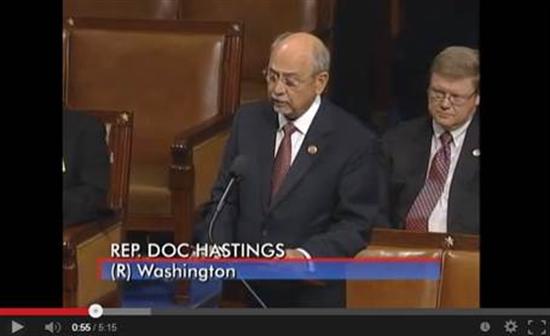Floor Statements
Chairman Hastings: Critical Minerals are Essential to American Jobs and our 21st Century Economy
WASHINGTON, D.C.,
September 18, 2013
|
Committee Press Office
(202-225-2761)
House Natural Resources Committee Chairman Doc Hastings delivered the following statement on the House floor today in support of H.R. 761, The National Strategic and Critical Minerals Production Act.
“Mr. Chairman, I rise today in strong support of H.R. 761, the National Strategic and Critical Minerals Production Act. Not a day goes by when Americans don’t use a product that is made from critical minerals. In fact, life as we know it in the 21st century would not be possible without minerals. There would be no computers, no blackberries or iPhones. There would be no MRI, CAT scan or X-ray machines. There would be no wind turbines or solar panels. The list is exhaustive of the things that depend on critical minerals that make modern life possible. Rare earth elements, a special subset of strategic and critical minerals, are core components for these products of the 21st century. Yet despite the tremendous need for rare earth elements, the United States has allowed itself to become almost entirely dependent on China and other foreign nations for these resources. America has a plentiful supply of rare earth elements, but roadblocks to the development of these crucial materials have resulted in China producing 97percent of the world’s supply. Our current policies are handing China a monopoly on these elements – creating a dependence that has serious implications on American jobs, our economy and our national security. Burdensome red-tape, duplicative reviews, frivolous lawsuits and onerous regulations can hold up new mining projects here in the U.S. for more than a decade. These unnecessary delays cost Americans jobs as we become more and more dependent on foreign countries for these raw ingredients. The lack of American produced strategic and critical minerals are prime examples of how America has regulated itself into a 100 percent dependence on at least 19 unique minerals. It has also earned the United States the unfortunate distinction of being ranked dead last when it comes to permitting mining projects. In 2012, the U.S. was ranked last, along with Papua New Guinea, out of twenty five major mining countries on the pace of permitting. Now, I can’t speak for Papua New Guinea, but the reason the U.S. is so slow to issue new mining permits is simple: Government bureaucracy. H.R. 761, introduced by Natural Resources Committee Member Mark Amodei of Nevada, will help to end this foreign dependence by streamlining government red tape that blocks American strategic and critical mineral production. Instead of waiting over a decade for mining permits to be approved, this bill sets a goal of the total review process for permitting at 30 months. This isn’t a hard deadline, it can be extended, but it is a goal to push the bureaucracies into action on these important infrastructure projects. It shouldn’t take a decade to get a project built for minerals we need for everyday life and our national security. Finally, above all, this is a jobs bill. The positive economic impact of this bill will extend beyond just the mining industry. For every metals mining job created, an estimated 2.3 additional jobs are generated. And for every nonmetals mining job created, another 1.6 jobs are created. This legislation gives the opportunity for American manufacturers, small businesses, technology companies, and construction firms to use American resources to help make the products that are essential to our everyday lives. As China continues to tighten global supplies of rare earth elements, we should respond with an American mineral mining renaissance that will bring mining and manufacturing jobs back to America. The National Strategic and Critical Minerals Production Act is important to jobs and our economy. We must act now to cut the government red tape that is stopping American mineral production and furthering our dependence on foreign minerals. Thank you and I reserve the balance of my time.” ### |
Newsletter Sign Up
Sign up to receive news, updates and insights directly to your inbox.

